Показатели местного иммунитета полости рта у пользователей новых видов табачной продукции
- Авторы: Островская И.Г.1, Абрамова М.Я.1, Паршков В.В.1, Мамацашвили В.Г.1
-
Учреждения:
- Российский университет медицины
- Выпуск: Том 27, № 7 (2024)
- Страницы: 40-45
- Раздел: Медицинская химия
- URL: https://journals.eco-vector.com/1560-9596/article/view/634415
- DOI: https://doi.org/10.29296/25877313-2024-07-06
- ID: 634415
Цитировать
Полный текст
Аннотация
Введение. Органы и структуры полости рта одними из первых приходят в контакт с аэрозолем при использовании электронных сигарет и систем нагревания сигарет (СНТ), а часть компонентов аэрозоля попадает в различные биологические жидкости рта, неизбежно провоцируя ответную реакцию организма на внешнее воздействие. Одними из маркёров ответной реакции являются иммуноглобулины, а их анализ призван помочь в изучении влияния электронных сигарет и СНТ на человека.
Цель исследования – cравнить лабораторные показатели иммуноглобулинов (Ig) А, G и М в десневой жидкости, смыве из полости рта и слюне у пользователей новых видов табачной продукции до и после курения, а также с аналогичными показателями у некурящих пациентов и потребителей традиционных сигарет.
Материал и методы. В пилотное исследование вошли 4 группы по 5 человек в каждой: курящие обычные сигареты, пользователи электронных сигарет, пользователи систем нагревания табака и некурящие. Для определения концентраций IgG, IgM и IgA у обследуемых осуществляли взятие десневой жидкости, слюны и смыва из полости рта.
Результаты. Разнообразные изменения концентрации иммуноглобулинов относительно группы контроля наблюдалось во всех группах курящих пациентов.
Выводы. Полученные результаты могут указывать на угнетение функции местного иммунитета как при воздействии табачного дыма, так и при воздействии аэрозоля СНТ или электронных сигарет, что, в свою очередь, повышает уязвимость органов и структур полости рта к патогенным микроорганизмам. При увеличении стажа курения отмеченные изменения могут способствовать развитию воспалительных заболеваний.
Ключевые слова
Полный текст
Об авторах
И. Г. Островская
Российский университет медицины
Автор, ответственный за переписку.
Email: pit.vadim@mail.ru
ORCID iD: 0000-0001-6788-4945
доктор медицинских наук, профессор
Россия, 127006, Москва, ул. Долгоруковская, д.4, стр.1М. Я. Абрамова
Российский университет медицины
Email: pit.vadim@mail.ru
ORCID iD: 0000-0001-7762-1540
доктор медицинских наук, профессор
Россия, 127006, Москва, ул. Долгоруковская, д.4, стр.1В. В. Паршков
Российский университет медицины
Email: pit.vadim@mail.ru
ORCID iD: 0009-0005-0074-3140
аспирант
Россия, 127006, Москва, ул. Долгоруковская, д.4, стр.1В. Г. Мамацашвили
Российский университет медицины
Email: pit.vadim@mail.ru
ORCID iD: 0009-0001-5571-9958
аспирант
Россия, 127006, Москва, ул. Долгоруковская, д.4, стр.1Список литературы
- National Center for Chronic Disease P, Health Promotion Office on S, Health. Reports of the surgeon general. In: The Health Consequences of Smoking-50 Years of Progress: A Report of the Surgeon General. Atlanta, GA: Centers for Disease Control and Prevention (US); 2014.
- Zong D., Liu X., Li J., et al. The role of cigarette smoke-induced epigenetic alterations in inflammation. Epigenetics Chromatin. 2019; 12: 65.
- Michcik A., Cichorek M., Daca A., et al. Tobacco smoking alters the number of oral epithelial cells with apoptotic features. Folia Histochem Cytobiol. 2014; 52: 60–68.
- Kinouani S., Pereira E., Tzourio C. Electronic cigarette use in students and its relation with tobacco-smoking: a cross-sectional analysis of the i-share study. Int. J. Environ. Res. Public Health. 2017; 14: 1345.
- Maj A., Kusiak A., Wojtaszek-Slominska A., et al. Electronic cigarettes use among 10–11-years old: Preliminary report. Dent. Forum. 2018; 46: 31–34.
- Smith D.M., Gawron M., Balwicki LSobczak A., et al. Exclusive versus dual use of tobacco and electronic cigarettes among adolescents in Poland, 2010–2016. Addict. Behav. 2019; 90: 341–348.
- WHO study group on tobacco product regulation: report on the scientific basis of tobacco product regulation: seventh report of a WHO study group / WHO study group on tobacco product regulation. Geneva: World Health Organization, 2019; 275 с.
- Bentley M.C., Almstetter M., Arndt D., et al. Comprehensive chemical characterization of the aerosol generated by a heated tobacco product by untargeted screening. Anal Bioanal Chem. 2020; 412(11): 2675–2685.
- St. Helen G., Jacob I.P., Nardone N., Benowitz N.L. IQOS: Examination of Philip Morris International’s claim of reduced exposure. Tob. Control. 2018; 27(Suppl.): s30–s36.
- Pisinger C., Dossing M. A systematic review of health effects of electronic cigarettes. Prev. Med. 2014; 69: 248–260. doi: 10.1016/j.ypmed.2014.10.009.
- Kaur G., Muthumalage T., Rahman I. Mechanisms of toxicity and biomarkers of flavoring and flavor enhancing chemicals in emerging tobacco and non-tobacco products. Toxicol Lett. 2018; 288: 143–155.
- Znyk M., Jurewicz J., Kaleta D. Exposure to Heated Tobacco Products and Adverse Health Effects, a Systematic Review. Int. J. Environ. Public Health. 2021; 18: 6651. doi: 10.3390/ijerph18126651.
- Giuca M.R., Pasini M., Tecco S., et al. Levels of salivary immunoglobulins and periodontal evaluation in smoking patients. BMC Immunol. 2014 Feb 6; 15: 5. doi: 10.1186/1471-2172-15-5.
- Nigar S., Hassan S., Maqsood A., et al. An assessment of unstimulated salivary flow rate, IgA and clinical oral dryness among active and passive smokers. Int J Occup Med Environ Health. 2022 Feb 15; 35(1): 39–51.
- Cichońska D., Kusiak A., Kochańska B., et al. Influence of Electronic Cigarettes on Selected Antibacterial Properties of Saliva. Int J Environ Res Public Health. 2019 Nov 12; 16(22): 4433.
Дополнительные файлы






